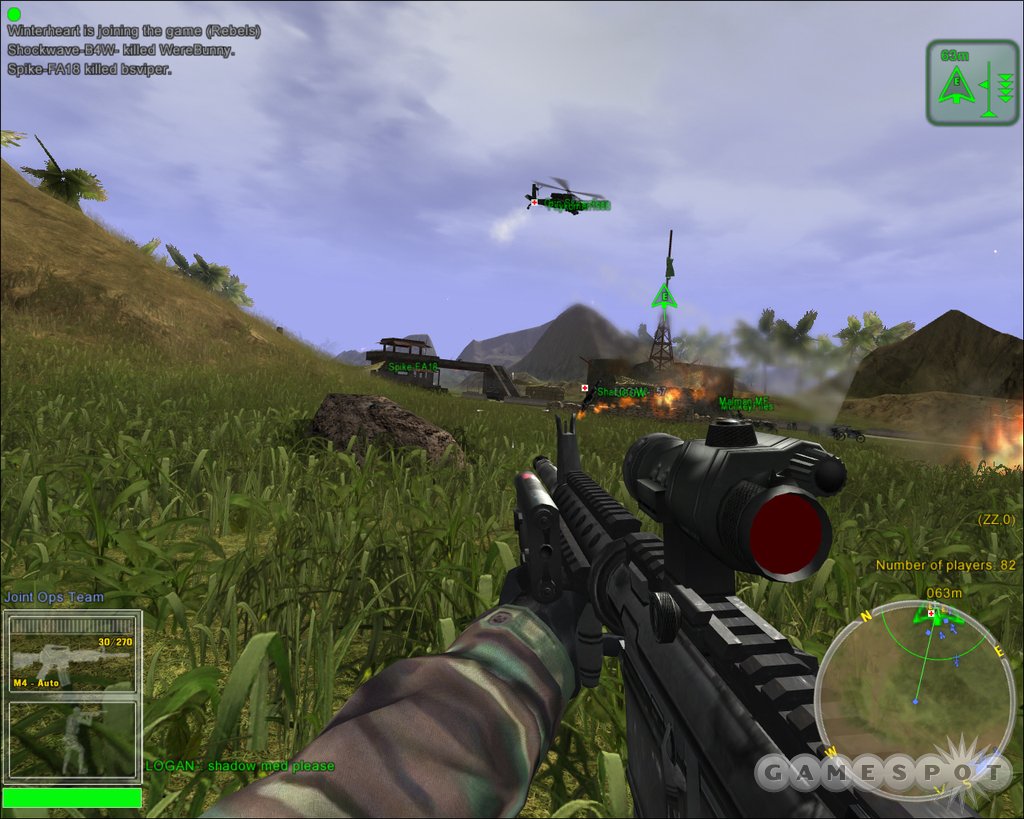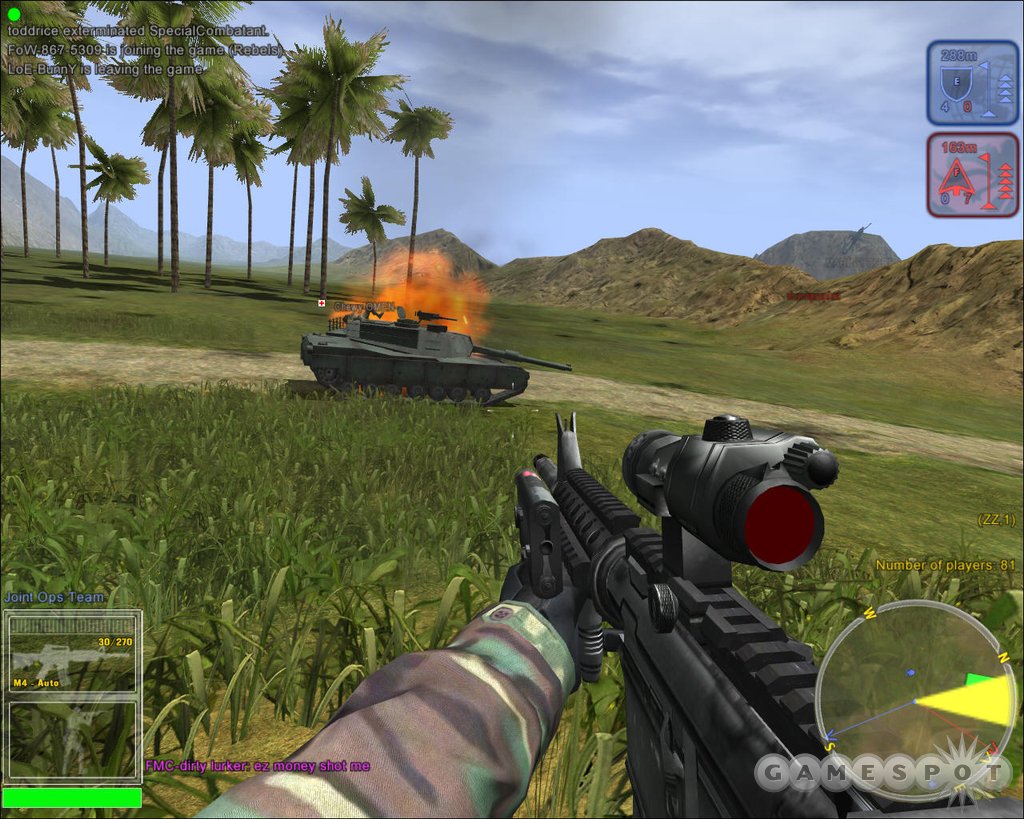When it was released earlier this year, Joint Operations: Typhoon Rising became a notable entry into the online military first-person shooter genre that's dominated by EA's Battlefield games. Far larger than Battlefield 1942 or Battlefield Vietnam, Typhoon Rising let you battle with up to 149 other players in a virtual, modern-day Indonesia torn apart by violence. It was a very fast-paced and chaotic game that offered lots of cinematic moments and rewarded coordinated teams of players. Joint Operations: Escalation picks up right where Typhoon Rising left off, and as its name suggests, this expansion pack ups the ante by introducing powerful new vehicles, new maps, and new weapons.

Typhoon Rising centered on an uprising by Indonesian militant forces threatening to destabilize the archipelago nation. Consequently, the United States and other Western nations dispatched their special operations forces to combat the militants. The combat in Typhoon Rising often centered on rapid movement by light infantry forces over large distances. In Escalation, the uprising escalates into full-scale warfare, and the focus now is on heavier forces, such as tanks and attack helicopters. While there are some new cooperative missions that you can carry out against a lackluster computer opponent, the focus in Escalation is once again on the competitive online multiplayer modes. And make no mistake: This remains an extremely fast-paced action game with an almost totally chaotic sense of combat to it.
It appears that NovaLogic paid heed to some of the feedback from Typhoon Rising players, because many of the maps in Escalation aren't as spread out and are better designed than those found in the original game. There's much more of an emphasis on land-based maps, rather than the sprawling, water-dominated maps of Typhoon Rising, primarily due to the fact that there are so many more vehicles to play with here. No longer do you have to endlessly wait for a ride to carry you from one island to another. Now you can jump on a vehicle or even try running for it, though the distances are still considerable. Most maps easily stretch several kilometers in size. And these new areas look better, thanks to the upgraded graphics engine. The maps have some memorable landmarks, such as an airfield packed with transport planes and helicopters, or a rail yard full of railcars, or a pipe-filled oil refinery. And yes, objects such as planes and fuel tanks explode if hit hard enough.
To help you get around these new levels, there are a wide range of new vehicles, including motorbikes, M-1 and T-80 tanks, and Apache and Hokum attack helicopters. These complement the existing transport helicopters and vehicles from the original game by adding hefty amounts of firepower. However, for all the offensive punch these new vehicles add, they're offset by the fact that most vehicles are death traps to be in during combat. Your life expectancy in the Apache and Hokum attack helicopters is usually measured in seconds once you begin a strafing run, due to the prevalence of so many Stinger missiles in the hands of infantrymen below. (It's even worse when you're sniped while sitting in the cockpit of an Apache while waiting for its engine to spool up. For all the armor on the real-world helicopters, you've got little protection from bullets in these virtual ones.) Meanwhile, tanks can fall prey to other tanks or, more likely, to an infantryman carrying the powerful Javelin antitank missile. Since tanks ideally require three crewmen to operate, it's possible to knock out three players like this in one fell swoop. However, you rarely see tanks with a full complement of crew, as most of the time it's simply easier for a single player to take a tank and jump between the driver and gunner stations, thus turning it into a mobile artillery piece.
Typhoon Rising's strength and weakness was the sheer chaotic sense of combat. This remains unchanged in Escalation. When all the players are working together, Escalation is nothing short of an exhilarating game, full of the sort of over-the-top Hollywood moments that make you feel like you're standing in the middle of a Jerry Bruckheimer movie. When vehicles explode in this game they go up in huge fireballs. And as they're exploding, helicopters will streak overhead, bullets will crack around you, and jeeps and motorcycles will zoom by. It's quite an intense and awe-inspiring experience to behold. But on the downside, it's also easy to feel like an insignificant cog on the battlefield, as it's hard to make a difference with so much going on around you.
It's also a bit frustrating when you just keep getting killed. It still seems too easy to die in Escalation, especially since most weapons remain wickedly accurate over long distances. The good news is that you can now select body armor as an equipment option, which lets you absorb more hits. So long as you're not hit in the head, you can usually survive long enough to maybe get a few kills in yourself. However, armor also makes you move slower. Plus, you're not allowed to carry special weapons, such as Stinger antiaircraft and Javelin antitank missiles, so your utility on the battlefield is reduced. And if you select the new parachute option, you can jump out of helicopters behind enemy lines, but at the price of not being able to carry body armor or missiles. In other words, there's not much for you to do other than snipe, and this sort of base-camping continues to be a source of irritation at times.

As mentioned, the graphics engine has received a few tweaks, but aside from the more detailed settings, it remains relatively the same. Still, Joint Operations remains a great-looking game, especially at high resolution. When it's in motion, there's a very strong sense that you're battling it out in a believable world. The sound effects remain roughly the same, though, and there are some strangely underwhelming noises, from the incredibly weak vehicle horns to the tinny sound of your assault rifle. The physics still border on the edge of cartoonish, particularly for vehicles. A perfect example is the new motorbike, which allows one or two players to zip across the landscape at high speeds. It's almost impossible to wipe out on a motorbike, no matter how reckless your driving is. You can zoom up hills and ridges and catch a ridiculous amount of air before you land, but you won't get thrown off no matter how hard you hit the ground. You'll only die if you slam into something solid.
Escalation is worth picking up if you're a Joint Operations fan, even if it's just for keeping up with all the other players. There are already some popular new levels in the expansion that will likely remain mainstays on NovaWorld, NovaLogic's online service, for quite some time. And if you haven't played Typhoon Rising before, Escalation helps make the Joint Operations experience an interesting and engaging one, though be prepared to face a noticeable learning curve and some frustrations at first.